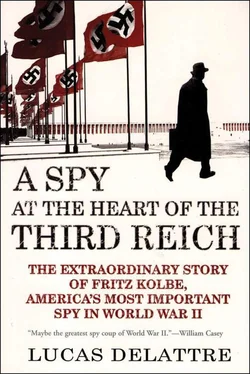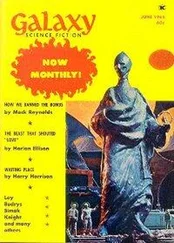packages, stamped “official dispatch”: In German, völkerrechtlich immun. The stamp had both French and German phrases.
envelope containing diplomatic cables: “Since he traveled on a diplomatic passport, the border controls never thought once to inspect closely the large envelope which he carried.” Unpublished, undated memoir by Allen Dulles, Allen W. Dulles Papers (box 114, file 11), Seeley G. Mudd Manuscript Library, Princeton.
despite official warnings: Internal circular of the Foreign Ministry (February 27, 1943) concerning the organization of diplomatic mail, Foreign Ministry archives.
with sturdy string: Biographical document by Gerald Mayer and Fritz Kolbe.
as a diplomatic courier: Fritz Kolbe had been trying unsuccessfully to secure an assignment as diplomatic courier to Switzerland since 1940. “The fact that he did not belong to the party kept him from being placed on the lists.” Biographical document by Gerald Mayer and Fritz Kolbe.
semivacation in Switzerland: The circle of the “privileged” was rather large, because the transport of diplomatic mail between Berlin and Bern took place every day, at least in the first years of the war. Those charged with carrying diplomatic mail were not supposed to have to high a rank in the ministry hierarchy.
his political reliability in writing: Autobiographical document written by Fritz Kolbe in Berlin in early January 1947.
the Ministry of Propaganda: Propaganda Ministerium, or Promi in common speech.
not repress a shiver: The Central Security Office of the Reich, Reichssicherheitshauptamt (RSHA).
the Askanischer Platz: The names are references to German history. The old princely house of Askania reigned over the duchy of Anhalt until 1918.
not bang into them: Source: Alfred Gottwaldt, Berlin, January 10, 2002. All the technical details on trains (including the schedules) were kindly provided by Mr. Gottwaldt, curator of the railroad department in the Technical Museum in Berlin.
front of the train: In 1939, the diplomat Theo Kordt traveled from Bern to Berlin in first class “because he was carrying dispatches” (Foreign Ministry, Theo Kordt file). During the war, first class was abolished on German trains (Alfred Gottwaldt).
Berlin (visa no. 519): Fritz Kolbe’s diplomatic passport has been kept by his son, Peter Kolbe, in Sydney. See illustrations.
Italian, and Austrian deserters: One of Fritz Kolbe’s friends had wanted to desert and go secretly to Switzerland. Kolbe had succeeded in dissuading him and brought him back to his barracks before his absence was noticed. Morgan, “The Spy the Nazis Missed.”
not display a Nazi flag: German diplomats feared hostile reactions from the Swiss population and made themselves as discreet as possible.
concealed beneath his pants: Where were the documents hidden? It is impossible to say. The hotel was not a secure place, because the owners had good relations with the German authorities (reservations were made by the Foreign Ministry).
known well since Spain: Otto Köcher had the title “envoy” ( Gesandte ), not ambassador ( Botschafter, which was reserved for diplomats serving in the major capitals; see ch. 1, n. 2) Otto Köcher was born in Alsace in 1884. He joined the Foreign Ministry in 1912, was vice-consul in Naples, then first secretary in Bern; legation adviser in Mexico City in 1924; consul general in Barcelona in 1933. Joined the NSDAP on October 1, 1934 (number 2,871,405). Head of the German legation in Switzerland from March 29, 1937. Very favorably evaluated by the hierarchy of the National Socialist Party. Also very much appreciated by the Swiss authorities (note that Köcher’s mother was Swiss). “George, from his Spanish times, was well acquainted with… Herr Köcher, who had been formerly Consul general in Barcelona” (Ernst Kocherthaler, “The Background of the George Story”).
nature of the place: “Everywhere, only happy people could be seen,” wrote Klaus Mann in his novel The Volcano.
south of the capital: Ernst Kocherthaler had settled in the heart of the Bern Oberland in September 1936 after fleeing from the Spanish Civil War. All his movements were closely scrutinized. His mail was opened. “Mr. Kocherthaler spends his time taking photos of the region,” “he receives many letters from abroad,” “he lives in the same chalet as Dr. Hans Schreck, a Bavarian who spied for Germany in 1916.” These are some of the observations noted down in police reports of the time, now preserved in the Ernst Kocherthaler file of the Swiss public archives (Federal Archives, Bern).
to many different versions: The first meeting among Fritz Kolbe, Allen Dulles, and Gerald Mayer is described in several archival documents: Memorandum of Gerry Mayer and Allen Dulles of August 28, 1943, National Archives; memorandum of OSS Bern of August 31, 1943, National Archives; biographical document by Gerald Mayer and Fritz Kolbe; various undated documents written by Allen Dulles (Allen W. Dulles Papers, Seeley G. Mudd Manuscript Library, Princeton).
attaché since September 1939: Cartwright was a man of action. He had escaped dozens of times from German internment camps during the First World War. Srodes, Allen Dulles, Master of Spies, p. 280.
in Bern that day: On the British intelligence network in Switzerland during the war, see the article by Neville Wylie in Intelligence & National Security, vol. 11, no. 3 (July 1996).
Alpenstrasse 29 and 35: This scene is described in the memorandum of Gerry Mayer and Allen Dulles of August 28, 1943, National Archives.
his office on Dufourstrasse: The OSS offices in Bern (officially the offices of the “special assistant to the American envoy”) occupied the second, third, and fourth floors of two residential buildings in the Kirchenfeld district. The ground floor was occupied by the offices of the Office of War Information (OWI) headed by Gerald Mayer, “press attaché” of the American legation. The premises were covered by diplomatic immunity. Miscellaneous Activities OSS Bern, undated internal document of the OSS Bern office, National Archives.
at nine that morning: Memorandum of August 28, 1943 by Gerry Mayer and Allen Dulles, National Archives.
War Information (OWI): Gerald Mayer sent thousands of leaflets, pamphlets, newspapers, brochures, and other printed matter into enemy territory during the war. “Mr. Mayer worked closely with Mr. Allen Dulles… and was of inestimable help to him, particularly in developing a contact which went into the heart of the German Foreign Office. This contact was generally recognized as being one of the outstanding intelligence sources of the war.” Statement of War Services of Mr. Gerald Mayer, sent April 24, 1947 by Allen Dulles to General Donovan, Allen W. Dulles Papers, Seeley G. Mudd Manuscript Library, Princeton. See also Miscellaneous Activities OSS Bern, National Archives.
“is okay with me”: Anthony Cave Brown, Bodyguard of Lies (New York: Harper & Row, 1975).
in the Kirchenfeld district: Gerald Mayer’s apartment was at Jubiläumsstrasse 97. Swiss Federal Archives, Gerald Mayer file.
Читать дальше











